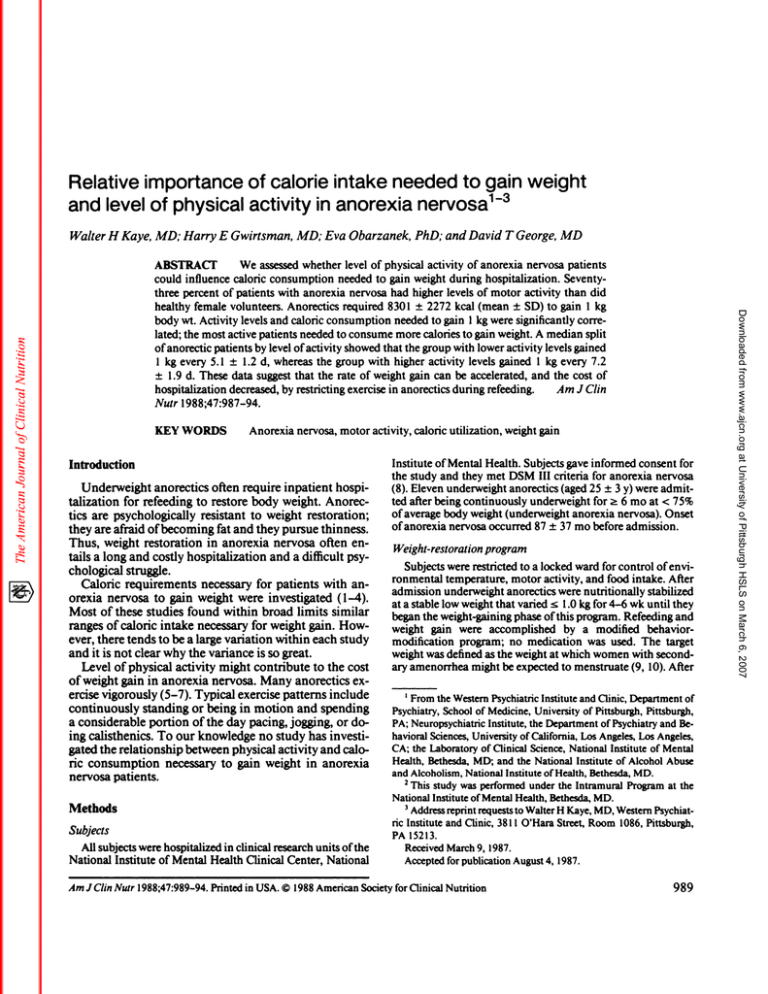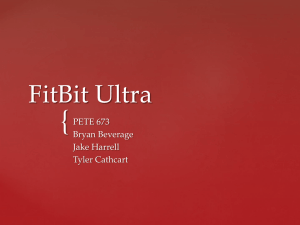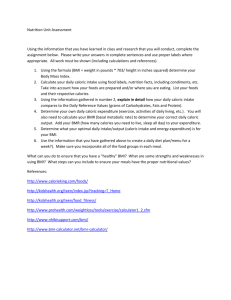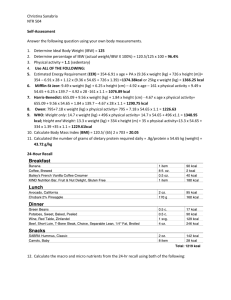Relative importance of calorie intake
advertisement

Relative
importance
and level of physical
Walter
H Kaye,
MD;
Harry
of calorie intake needed to gain weight
activity
in anorexia
nervosa13
E Gwirtsman,
MD;
We assessed
Eva
Obarzanek,
and David
T George,
MD
activity of anorexia nervosa patients
weight during hospitalization.
Seventythree percent of patients with anorexia
nervosa had higher levels of motor activity than did
healthy female volunteers.
Anorectics
required
8301 ± 2272 kcal (mean ± SD) to gain 1 kg
body wt. Activity
levels and caloric
consumption
needed
to gain I kg were significantly
correlated; the most active patients needed to consume more calories to gain weight. A median split
ofanorectic
patients by level ofactivity
showed that the group with lower activity levels gained
ABSTRACT
could
influence
5. 1 ± 1.2 d, whereas
1 .9 d. These
hospitalization
consumption
data
suggest
decreased,
Nutr
1988;47:987-94.
KEY
WORDS
Anorexia
that
level of physical
needed
to gain
the
group
with
the
rate
of weight
by restricting
nervosa,
exercise
motor
Underweight
anorectics
often
require
inpatient
hospitalization
for refeeding
to restore
body weight.
Anorectics are psychologically
resistant
to weight
restoration;
they are afraid ofbecoming
fat and they pursue thinness.
Thus, weight
restoration
in anorexia
nervosa
often entails a long and costly hospitalization
and a difficult
psychological
struggle.
Caloric
requirements
necessary
for patients
with anorexia
nervosa
to gain weight
were investigated
(1-4).
Most of these studies
found within
broad limits similar
ranges of caloric intake necessary
for weight gain. However, there tends to be a large variation
within each study
and it is not clear why the variance
is so great.
Level of physical
activity
might contribute
to the cost
ofweight
gain in anorexia
nervosa.
Many anorectics
exercise vigorously
(5-7). Typical
exercise
patterns
include
continuously
standing
or being in motion
and spending
a considerable
portion
ofthe
day pacing,
jogging,
or doing calisthenics.
To our knowledge
no study has investigated the relationship
between
physical
activity
and cabric consumption
necessary
to gain weight
in anorexia
nervosa
patients.
Methods
Subjects
All subjects
were hospitalized
in clinical research units of the
National Institute of Mental Health Clinical Center, National
Nuir l988;47:989-94.
Printed
in USA.
C 1988 American
Society
activity
levels
gained
1 kg every
7.2
gain can be accelerated,
and the cost of
in anorectics
during refeeding.
Am J C/in
activity,
Introduction
Am IC/in
higher
caloric
utilization,
weight gain
Institute ofMental
Health. Subjects gave informed consent for
the study and they met DSM III criteria for anorexia
nervosa
(8). Eleven underweight
anorectics
(aged 25 ± 3 y) were admitted after being continuously
underweight
for
6 mo at < 75%
ofaverage
body weight (underweight
anorexia nervosa). Onset
ofanorexia
nervosa occurred
87 ± 37 mo before
admission.
Weight-restoration
Subjects
ronmental
admission
program
were restricted
temperature,
underweight
to a locked
ward for control of enviintake. After
motor
activity,
and food
anorectics
were nutritionally
that varied
1.0 kg for 4-6
stabilized
at a stable low weight
wk until they
began the weight-gaining
phase ofthis program. Refeeding and
weight gain were accomplished
by a modified
behaviormodification
program;
no medication
was used. The target
weight was defined as the weight at which women with secondary amenorrhea
might
be expected
to menstruate
(9, 10). After
I
From
the Western
Psychiatric
Institute
and Clinic,
Department
of
Psychiatry,
Schcol of Medicine,
University
of Pittsburgh,
Pittsburgh,
PA; Neuropsychiatric
Institute,
the Department
ofPsychiatry
and Behavioral
Sciences,
University
ofCalifornia,
Los Angeles,
Los Angeles,
CA; the Laboratory
of Clinical
Science,
National
Institute
of Mental
Health,
Bethesda,
MD; and the National
Institute
of Alcohol
Abuse
and Alcoholism,
National
Institute
ofHealth,
Bethesda,
MD.
2 This study
was performed
under the Intramural
Program
at the
National
Institute
ofMental
Health, Bethesda,
MD.
3 Address
reprint requeststo
Walter H Kaye, MD, Western
Psychiatric Institute
and Clinic, 381 1 O’Hara
Street, Room
1086, Pittsburgh,
PA 15213.
ReceivedMarch9,
1987.
Accepted
for publication
August 4, 1987.
for Clinical
Nutrition
989
Downloaded from www.ajcn.org at University of Pittsburgh HSLS on March 6, 2007
1 kg every
±
caloric
whether
PhD;
KAYE
ET AL
anorectics
were again
asked
to maintain
a
(±1.0
kg) for 4-6 wk. We previously
reconsumption
necessary
to maintain
weight
or low-weight,
state and after short-term
in these
1 1 patients
(1 1).
were
990
weight
stable
ported
in the
weight
restoration
body
weight
the caloric
underweight,
restoration
Subjects
subjects
and
were weighed
had
voided.
daily
by the nursing
Subjects
were
staffat
dressed
only
was a Scale-
hospital
gown. The scale used
Tronix (model #5005, White Plains, NY).
During hospitalization
subjects
were provided
per meal per day and three
on the ward
All subjects
times
were
and
were allowed
observed
15-mm
to have
24 h/d
after
in underpants
a standard
periods
patients
0630
three
food
in their
on the ward,
No
rooms.
meal
binging,
including
on
corded
the
tray
to the
the amount
main
kitchen.
assistant
re-
left on the tray. Registered
dietitians
then determined
the amount
of food removed
from
the tray by subtracting
the food left on the tray from the food
sent to the patient.
Caloric intake was calculated
from food cxchange lists and food composition
tables (12) and from Atwater’s nutrient
carbohydrate,
and kind
A dietetic
conversion
fat, and
offood
factors
protein,
(13) of 4, 9, and
respectively.
The
our method
of caloric estimation
dent study (12). Clinical
caloric
ofthe values found by chemical
was a nonsignificant
for
of
was checked
in an indepenestimates
were 102.4 ± 2.2%
laboratory
calorimetry,
which
difference.
After the period
the weight-gaining
tients ate ---20-30
weight-gain
4 kcal/g
accuracy
ofunderweight
stabilization,
patients
began
program.
In the underweight
period
pakcal. kg
d’ to maintain
their weight. The
.
program
day. This was done
involved
for both
a gradual
psychological
increase
in calories
(resistance
per
to eating
increased
amounts
of food)
and physiological
(concerns
with
gastrointestinal
distention)
reasons.
Thus, we began the weightrestoration
part ofthe
program
by giving the patients
40 kcal.
kg
.
d
and gradually
increasing
havior-modification
program
kgJwk.
rule
As a general
this amount
requires
many
patients
a weight
offood.
gain
needed
The beof 1.0-1.5
to have
their
caloric
intake
increased
at intervals
to maintain
this rate of
weight
gain. Patients
gained
13.5 ± 3.2 kg (mean
± SD) in 79
± 14 d (Table
1). The weight-restoration
portion
of the program was terminated
when patients
achieved
target weight.
For the most part solid food was consumed;
only rarely were
patients
given
liquid
feedings.
Patients
required
tube
feeding
even less often. The compliance
of our patients
was probably
due to their being an older, more chronically
ill group. In fact,
only two patients
(#5 and #1 1) had not been previously
hospitalized for weight gain. Thus, the majority
of the patients
had
experienced
inpatient
treatment.
The procedures
followed
in this study were in accord with
the ethical standards
of the NIMH
Institute
Clinical
Research
Subpanel.
Methodfor
cakulating
We previously
reported
to maintain
weight
term
restoration
weight
the lengthy
duration
calories
to gain
(1 1) caloric
in the underweight
for these
ofthese
patients
weight-stable
weight
consumption
state
and
(Table
periods,
necessary
after
short-
1). Because
these
values
restoration
and
calculating
the area
of
under
that
line.
We
assumed
that the amount
of maintenance
caloric
requirement
gradually increased
as weight was gained. Caloric
consumption
was measured
daily during weight restoration.
The total caloric
consumption
over the period of weight gain was summed
(F)
the calculated
maintenance
caloric requirement
during weight gain. The excess caloric intake(H),
which
was the difference
between
actual
caloric intake
and estimated
ories
caloric
needed
for
requirements,
weight
gain.
was assumed
to be the cab-
We
divided
this
of kilocalories
consumption
by the number
weight restoration
to obtain an estimate
excess
caloric
gained
during
ofcalories
required
to
gain 1 kgbodywt(I).
Motor
activity
Motor
activity
five separate
ings
were
ported
was automatically
phases(Table
made
of activity
for
wt),
Motor
device
with
(14-16).
3-5
phase
d (24
and after
activity
Thus,
during
continuous
h/d)
four or
record-
by methods
re-
had their motor activity recorded
in the underweight
state on two or three occasions during
weight
gain (approximately
after each gain of 10%
body
previously
recorded
2). In each
weight
restoration.
was measured
a solid-state
subjects
memory
by an acceleration-sensitive
that
stores
data
on the num-
ber of motor movements
( 16). The monitors were attached to
belts around the waists ofthe subjects and thus reflected trunk
and leg movement.
Two monitors
were used on each subject
throughout
the study. These monitors
were individually
callbrated to be equal to each other and they maintained
a variance
of < 7% throughout
the study. We calculated
mean daily activity levels during
hospitalization
and used these data as an index
ofoverall
activity during hospitalization.
We intended this study to be a naturalistic
study of caloric
requirements
and
Thus, we allowed
associated
anorectics
factors during weight restoration.
to exercise ad lib during their hos-
pitalization
as long as they stayed on the locked ward. Anorectics were permitted
to exercise
in their rooms, in the lounge, or
in the halls.
They
down the hallway
St atistical
Statistical
most
commonly
along the length
exercised
ofthe
by walking
up and
unit.
analyses
tests included
correlation
analysis
correlation
coefficient
(17),
coefficient
a covariance
and two-tailed
of variance
and
analysis(18),
and
group t test (19).
linear
partial
Results
We found that the mean ± SD caloric intake necessary
to gain 1 kg body wt was 8301 ± 2272 kcal (Table
1).
Individual
values, however,
revealed
almost
a threefold
range ofcabories
required
to gain 1 kg(456
1 - 1 2 723 kcal)
with a CV of 27%.
Anorectics
had more than a twofold
range of mean
activity
counts
(1524-3457
counts/24
h) during
the
course of weight restoration.
As can be seen in Table 2,
most anorectic
subjects
tended
to show relatively
consistent activity
levels throughout
hospitalization.
In fact,
Downloaded from www.ajcn.org at University of Pittsburgh HSLS on March 6, 2007
visits, to prevent
surreptitious
vomiting,
or hiding
of food. Food in the centralized
kitchen
was prepared
from standardized
recipes. Standardized
serving
utensils
were used to portion
food not already
proportioned.
Meat was the only food item weighed.
The tray was checked
for accuracy
at the end ofthe serving line by a dietetic assistant.
After the subjects ate, the remaining
portions
offood
were sent
back
bathroom
weight
and from this value we subtracted
45-mm
snack periods.
presumably
a good approximation
of caloric
requirements for weight maintenance.
We calculated
maintenance
caloric requirements
(Table
1, G) during weight gain by extrapolating a line between
the underweight
state and short-term
ACTIVITY
TABLE
Results
AND
WEIGHT
GAIN
1
ofthe
Patient
no
weight-restoration
program
Maintenance
mean daily
Maintenance
mean daily
caloric intake
at low weight
Mean weight
at low weight
after weight
(A)t
(B)t
(C)t
Height
cm
caloric
kcal
intake
restoration
kg
Calculated
Days of
Mean
weight
feeding
after weight
restoration
necessary
for weight
(D)t
gain (E)
keal
kg
maintenance
caloric
excess caloric
Calculated
intake during
weight gain
(H)
calories
weight gain
(F)
requirements
during weight
gain (G)
kcal
kcal
kcal
kca/
117617
122148
12723
intake during
172
925
39.9
2130
49.5
77
239766
168
1168
36.6
2001
49.5
51
165738
3
4
160
159
713
963
601
1150
1163
939
32.6
30.8
32.5
31.7
25.5
33.4
2068
1451
1807
2399
2645
2197
47.4
44.1
47.6
46.1
43.5
40.6
71
95
III
74
81
73
29.9
2592
41.6
82
28.6
27.9
31.8
3.8
2203
2214
2155
323
41.7
46.5
45.3
3.0
76
166236
242350
296830
212870
272097
182765
250430
233057
81
79
14
5
170
169
159
157
9
154
927
10
11
155
159
162
1029
1015
963
171
Mean
SD
6
(A x E)
These
+
(C -A) x E/2), H
=
F-li,
2
levels(counts/d)
(I)
84469
6548
98725
114665
133644
131313
154224
114464
67510
127685
163186
81557
117873
68301
4561
9600
10807
5663
6548
9486
144279
106051
9072
122816
110241
8415
277596
130774
146821
7983
230885
42523
122163
19459
108722
29709
8301
2272
1).
at five phases
When
activity
counts
were
necessary
to gain 1 kg body wt
cant positive
relationship
(r =
gests that the anorectics
with
the greatest
amount
ofcaboric
Because
the effect of activity
correlated
with calories
(Fig 1) we found a signifi0.73, p < 0.02). This sugthe most activity
required
intake to gain 1 kg.
is included
in our estimate ofcaboric
cost ofweight
maintenance,
it was important to examine
activity
levels in greater
detail.
We
wanted
to discern
whether
activity
levels were also an
important
determinant
of energy
requirements
for
of treatment
PhaseS
weight
restoration
(at 45.3 kg)
after
Patient
no
Phase 1
at low weight
Phase 2
at 35.1 kg
Phase 3
at 38.9 kg
Phase 4
at 42.9 kg
Mean during
hospitalization
CV during
hospitalization
%
3500
2369
3252
3372
16
2311
2693
13
-
1416
1048
1224
11
3174
2370
2540
1847
2760
25
1
2550
3363
4195
2
3249
2957
2582
3
1209
1220
4
3870
5
6292
-
3154
2723
1662
3457
50
6
2099
-
1532
1323
2477
1857
26
7
2833
3183
3302
2963
3087
5
8
2330
2882
3155
3504
3124
3066
2981
13
2414
2901
32165
3378
2721
23
2808
3034
2662
2901
6
9
1655
10
3103
11
1200
1211
1694
1730
1786
1524
17
Mean
2533
2267
2536
2356
2204
2597
19
SD
1375
704
12
C
Mean
weight
for each phase
to
1 kg
1= H/(D -B).
data come from an earlierstudy(l
the CVs
of activity
counts
during
hospitalization
were between
5 and 25% in 10 of the subjects.
One patient (patient
6) had a CV of 50% because
of very high
activity
counts
(mean
of 6292) during
the underweight
state which decreased
during weight restoration.
By way
of comparison,
healthy
control
women
studied
under
similar conditions
(1 1) had activity
levels of 1400 ± 423
counts/d
(range 824-2183
counts/d).
Only 3 of the 1 1
anorectics
in this study had mean activity
counts
that
were within the range ofhealthy
control
women.
TABLE
Activity
81268
gain
-
814
oftreatment
759
is shown.
738
712
Downloaded from www.ajcn.org at University of Pittsburgh HSLS on March 6, 2007
I
6
7
8
Calculated
caloric
Total
2
t
991
IN ANOREXIA
992
KAYEETAL
4000
tive
0
3000
ACTIVITY
(C09TIs/24
I1.
2000
.02
g4g,,=
#{149}No..-B.I.mo
0<
0
0
sooo
CONSUMPTIOO4
FIG 1. Correlation
between
necessary
for gain of 1 kg body
mean
wi (n
‘0.000
PIECESSAAY
(Ocal)
activity
=
TO 0*04
and caloric
still a significant
contributor
to variability
ofweight
gain.
Instead
of rebating
activity
bevels to the caloric
cost of
weight gain, which depends
on the accuracy
and validity
of our estimate
of calories
required
to maintain
weight,
we compared
activity
bevels with the number
of days it
took to gain 1 kg. We did a median
split between
the five
anorectics
with the lowest bevels of activity
(mean
2002
± 606 counts/d)
and the six anorectics
with the highest
levels of activity
(3093
± 249 counts/d).
These
two
groups
consumed
similar
numbers
of calories
per day
during
weight gain (2990 ± 373 vs 2878 ± 319 kcab/d)
± 2.3 vs 12.7
± 3.5 kg). However,
the group with bower activity
gained
1 kg every
5. 1 ± 1.2 d whereas
the group
with
higher
activity
gained
b kg every 7.2 ± 1.9 d, a significant
difference (1 = 2. 13, p < 0.05). In other words, despite
having
12.000
Kg
consumption
1 1).
similar
daily caloric intakes
the group with lower activity
1 kg while the group with higher activity
gained
only 0.7 1 kg in the same 5-d period.
We found no difference
between
bulimic
and nonbulimic anorectics
in terms ofcabories
needed
to gain 1 kg
or in activity
counts during weight restoration.
gained
weight
maintenance.
No relationship
between
activity
levels and caloric
intake was found in the underweight
state (r = 0.34) whereas
there was a trend towards
such a
relationship
(r = 0.59) after weight restoration.
Most importantly,
however,
it was necessary
to determine whether
activity
levels varied differentially
across
the three periods
of hospitalization:
during
low weight,
during
weight restoration,
and after weight restoration.
We found that there was a relatively
small change in activity counts
across periods
for most patients.
Thus, in
most subjects activity
did not greatly increase
or decrease
over time and therefore
would not have biased our estimate of caloric cost of weight
maintenance
at the lowweight
and weight-restored
phases
of hospitalization.
Moreover,
there was no significant
difference
in mean
activity
counts
at each phase of treatment.
To remove
the influence
ofactivity
to obtain an estimate
ofthe cabric cost ofweight
gain, we covaried
maintenance
caloric
intake
with activity
levels
to recalculate
the excess
amount
ofcabories
necessary
to gain 1 kg body wt. This
recalculation
made no appreciable
difference
in the calories necessary
to gain 1 kg (830 1 vs 8022 kcal). After recalculation
a significant
relationship
between
mean
ac-
tivity levels during
hospitalization
and caloric
cost of
weight gain remained.
It was also possible
that body size might
be a confounding
variable
in assessing
the caloric
expenditure.
Subjects
with greater body mass might require more cabories to gain weight because
they might expend more cabories for a given degree of physical
activity.
We found
that the partial
correlation
coefficient
between
activity
bevels and calories needed to gain 1 kg ofweight
independent of body weight was similar
(r = 0.74) to the unadjusted correlation
reported
above. We also found that the
partial
correlation
coefficient
between
activity
levels and
caloric intake independent
ofbody
weight was similarly
significant
for underweight
anorectics
(r = -0.34)
and
for anorectics
after weight recovery
(r = 0.52).
Discussion
This study shows that amount
ofphysical
activity
may
be an important
factor in caloric needs during weight restoration
even when opportunity
and scope of physical
activity
are limited to the boundaries
ofan inpatient
hospital ward.
Mean caloric
intake
(and CVs) in this and
other studies
that have examined
the calorie
requirements for weight gain in anorectics
were similar
(Table
3). In the four studies
listed
in Table 3, the mean number
of calories
required
to gain 1 kg body wt ranged
from a
bow of5340
kcal (4) to a high of9768
kcal (3). Except for
the metabolic-balance
study ofRussell
and Mezey (1) in
which the CV ofcaboric
requirements
for weight gain was
low (8%), previous
studies (2-4) and the present
one report a large degree ofvariability
(25-43%).
One factor that may account
for variation
in caloric
TABLE
3
Chronic
requirements
for weight
gain
in anorexia
nervosa:
results
from five studies
of
Cost
References
weight
gain
kcal/kg
%
RussellandMezey,l962(l)
7525±
Walkeretal,l979(2)
6401±1627
25
Dempseyetal,1984(3)
9768±4212
43
Forbesetal,l984(4)
Present study
5340±1850
35
8301
27
C
Mean
± SD.
585
CV
± 2272
8
Downloaded from www.ajcn.org at University of Pittsburgh HSLS on March 6, 2007
eooo
CALORIC
from a different
perspecinfluence
of activity
was
andgainedsimibaramountsofweight(l4.5
‘000
4000
Finally,
we analyzed
the data
to determine
whether
the
AND WEIGHT
ACTIVITY
food-intake
estimates
is likely
to be small.
The
estimate
of caloric
requirements
necessary
to maintain
weight is derived
from caloric intake measurements
responding
to long periods
of consecutive
days,
1 1 ± 5 d for
underweight
anorectics
and
23
body
corlasting
± 1 1 d for
short-term
weight-recovered
anorectics,
during
which a
stable body weight was maintained
(1 1). These measurements should
therefore
serve as a reasonably
good estimate ofcaloric
requirements
for weight maintenance.
The excess calories
consumed
during weight gain were
adjusted
to reflect the increasing
energy
cost of weight
maintenance
that occurs with weight gain. This method
of estimating
maintenance
caloric
requirements
from
which excess calories
consumed
were calculated
differs
from other studies because
the method
is empirically
determined.
Except
for the balance
study of Russell
and
IN ANOREXIA
993
Mezey
(1) in which 24-h energy
sured,
previous
studies
estimated
quirements
by adding an arbitrary
either measured
resting metabolic
ing
metabolic
rate
derived
expenditure
was meabaseline
energy
refigure of 10 or 50% to
rate or predicted
rest-
from
a nomogram.
In
this
study, rather than relying on arbitrary
assignment
of energy costs of activity
and food, we used documented
weight-stable
periods
to estimate
energy
requirements
for weight maintenance.
In a previous
study (1 1) we reported
that the same patients divided
into bulimic
and nonbulimic
subgroups
had differences
in caloric
consumption
necessary
to
maintain
both low weight and weight after refeeding.
Activity bevels of bubimic
and nonbulimic
subjects
did not
appear
to be responsible
for the differences
in caloric
consumption
for weight
maintenance.
It is not known
why bulimic
and nonbulimic
anorectics
have differences
in caloric
intake
necessary
to maintain
weight.
In the
present
study, differences
in maintenance
caloric intake
between
bulimic
and nonbulimic
anorectics
were factored
out because
maintenance
caloric
requirements
(Table
1, 0) were subtracted
from total caloric
intake
(Table
1, F).
In summary,
these data may be clinically
important
in terms
because
of treatment
they
suggest
significantly
of patients
that
increased
with
anorexia
the rate of weight
if physical
exercise
gain
nervosa
may
is limited.
be
To
our knowledge
no previous
study has quantitated
the rebationship
between
activity
and the caloric requirements
for gaining
weight.
Minimizing
activity
during
weight
gain may significantly
decrease
the number
of days of
hospitalization
necessary
for weight
restoration
in anorexia nervosa
patients.
Restriction
of physical
activity,
however,
may have
several
effects on anorectics.
Rigotti et al (2 b) found that
a high level ofphysical
activity
may protect
bone density
in anorexia
nervosa
because
anorectics
with bow bevels of
activity
had
more
extensive
osteoporosis.
It remains
to
be determined
whether
restricted
activity
during
several
months
of weight
gain would
contribute
to significant
change in bone density.
It is also possible
that restricting
activity
may increase
the proportion
of weight
that is
gained as fat mass instead
ofas fat-free mass. An increase
in fat mass may be psychologically
repugnant
to anorectics although
it may be physiologically
beneficial
given
their severe fat-mass
deficit.
B
The authors
Petersen,
C Jimerson
and
wish to thank
the
nurses
for reviewing
Sandra
of 3E for
Nicotra,
their
valuable
Susan Lesser,
assistance
Rosemary
and David
this manuscript.
References
1. Russell GFM, Mezey AG. An analysis
of weight gain in patients
with anorexia
nervosa
treated
with high calorie
diets. Clin Sci
l962;23:449-6
1.
2. Walker J, Roberts
SL, Halmi KA, Goldberg
SC. Caloric
requirements
for weight
gain in anorexia
nervosa.
Am J Clin Nutr
1979;32: 1396-400.
Downloaded from www.ajcn.org at University of Pittsburgh HSLS on March 6, 2007
cost ofweight
gain is possible
differences
in body composition.
In two studies
that measured
body composition
(1, 4), it was evident
that the greater the proportion
of fat
gained,
the greater the caloric cost ofweight
gain. Unfortunately
it was not possible
to measure
the composition
ofweight
gain in this study.
However,
we were able to monitor
activity
ofthe subjects. Varying
amounts
ofphysical
activity
could be a potent factor influencing
caloric requirements.
Ravussin
et
al (20) recently
reported
thatfidgetiness
(motor
activity
not connected
with overt exercise
or physical
activity)
is
an important
determinant
of 24-h energy
expenditure
that can account
for a significant
portion
ofits variation.
Because
we found
a significant
positive
correlation
between activity
and energy cost of weight gain, this study
supports
the idea that in addition
to body composition,
physical
activity
could be an important
clinical
factor
underlying
the variability
in the energy requirements
for
weight gain. Physical
activity
could also be a factor underlying
the degree
of resistance
to weight
gain that has
been commonly
observed
in anorectics.
Activity
counts
measured
in this study are not necessarily linearly
rebated to, nor are they a direct measure
of,
energy
expenditure.
Therefore,
they cannot
be used to
estimate
the portion
ofthe
24-h energy requirements
attributable
to activity.
Nevertheless,
activity
counts
are a
qualitative
indicator
of the amount
of physical
activity
subjects
engage
in. Because
the activity
monitors
were
placed on the subjects’
waists, the measurements
reflect
large muscle
movements
of the trunk and legs. Activity
counts
induced
by barge groups
of muscles
would therefore be indicative
of higher
caloric
expenditures
compared with expenditures
when resting,
standing,
or sitting.
Because
this study was not designed
as a metabolic
balance study, the results
are not based on precise
direct
measurements
of all components
of energy
balance.
Nevertheless,
they can be used to estimate
energy
requirements
ofweight
gain indirectly.
The accuracy
of caboric intake
was previously
documented
(12) and was
shown to be 102% ofactual
values as measured
by chemical determinations.
Thus
the error
introduced
from
GAIN
994
KAYE
3. Dempsey
4.
5.
6.
7.
8.
9.
10.
1 1.
12.
take for patients
hospitalized
foreating
disorders.
J Am Diet Assoc
1986;86:490-2.
13. Merrill AL, Watt BK. Energy value offood.
Washington,
DC: US
Government
PrintingOffice,
l973.(US
Department
of Agriculture
handbook
#74.)
14. Porrino LI, RapoportJL,
Behar D, Sceery W, Ismond DR, Bunney
WE. A naturalistic
assessment
ofthe
motor
activity of hyperactive
boys I Comparison
with normal
controls
Arch Gen Psychiatry
l983;40:68
1-7.
15. Wehr TA, Goodwin
FK. Biological
rhythms
and psychiatry.
In:
Arieta S, Brodie HK, eds. American
handbook
ofpsychiatry.
New
York: Basic Books, 1981:46-74.
16. Colburn
T, Smith BM, GUarini J. An ambulatory
activity monitor
with solid state memory.
Instr Soc Am Trans 1976; 15:149-54.
17. Richmond
SB. Principlesofstatistical
analysis. New York: Ronald
Press, 1957.
18. Mood AM, Graybill FA, Boes DC. Introduction
to the theory of
statistics.
New York: McGraw-Hill,
Inc, 1974.
19. Peters CC, Van Voorhis
WR. Statistical
prncedures
and their
mathematical
bases. New York: McGraw-Hill
Book Co. 1940.
20. Ravussin E, Lillioja S, Anderson TE, Christin L, Bogardus C. Dcterminants
of 24-hour
energy expenditure
in man: methods
and
results using a respiratory
chamber.
J Clin Invest l986;78: I 56878.
21. Rigorti NA, Nussbaum
SR, Herzog DB, Neer RM. Osteoporosis
in women
with anorexia
nervosa.
N EngI J Med
l984;3l
1:
1601-6.
Downloaded from www.ajcn.org at University of Pittsburgh HSLS on March 6, 2007
DT, Crosby LO, Pertschuk
MJ, Feurer ID, Buzby GP,
JL. Weight gain and nutritional efficacy in anorexia
ncrvosa. Am J Clin Nutr 1984; 39:236-42.
Forbes BG, Kreipe RE, Upinski
BA, Hodginan
CH. Body composition changes during recovery from anorexia
nervosa:
comparison
oftwo
dietary regimes. Am J Clin Nutr 1984;40: 1137-45.
Foster FO, Kupfer DJ. Anorexia
nervosa: telemetric
assessment
of
family interaction and hospital events. J Psychiatr Res 1975; 12:
19-35.
KronL,
Katz JL, Gorzynski
G, Weiner
H. Hyperactivity
in anorexia nervosa: a fundamental
clinical feature. Compr Psychiatry
1978; 19:433-40.
Falk JR, Halmi KA. Activity
measures
in anorexia
nervosa.
Arch
Gen Psychiatry
1985;42:8l
1-4.
American
Psychiatric
Association. Diagnostic
and statistical mantial ofmental disorders. 3rd ed. Washington,
DC: APA, 1980.
Frisch RE. Food intake, fatness, and reproductive
ability in anorexia nervosa. In: Vigersky R, ed. Anorexia nervosa. New York:
RavenPress,
1977:149-61.
Falk JR, Halmi KA. Amenorrhea
in anorexia
nervosa:
examinanon of the Critical body weight hypothesis.
Biol Psychiatry
1982; 17:799-806.
Kaye WH, Gwirtsman
HE, Obarzanek
E, George T, Jimerson DC,
Ebert MH. Caloric intake necessary
for weight maintenance
in anorexia nervosa: nonbulimics
require greatercaloric
intakethan
bulimics. Am J Clin Nutr 1986;44:435-43.
Petersen
R, Kaye WH, Gwirtsman HE. Estimation
of caloric inMullen
ET AL




